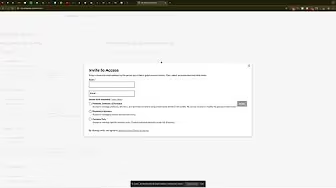Managing multiple domains or collaborating with team members, clients, or agencies often requires delegating access to your GoDaddy account. Whether you need someone to manage your domains, update DNS settings, or handle purchases, GoDaddy’s Delegate Access feature provides a secure and efficient way to grant the necessary permissions without sharing your personal login credentials. In this comprehensive guide, you’ll learn how to give someone else access to your GoDaddy account, understand the different access levels, and implement best practices to maintain the security and integrity of your online assets.
Why Delegating Access in GoDaddy Matters
Delegating access in GoDaddy is essential for businesses and individuals who manage multiple domains or require assistance from others in maintaining their online presence. Proper delegation ensures that tasks are handled efficiently while maintaining control over your account’s security and settings.
Benefits of Delegating Access
- Efficient Management: Allow team members or agencies to manage specific aspects of your account, such as domains or DNS settings, without granting full access.
- Enhanced Collaboration: Facilitate seamless collaboration with clients, developers, or marketing professionals by providing them with the necessary permissions.
- Improved Security: Reduce the risk associated with sharing your personal login credentials by assigning specific roles with limited access.
- Time-Saving: Streamline workflows by enabling delegated users to handle routine tasks, freeing up your time for more strategic activities.
Step-by-Step Guide to Delegate Access in GoDaddy
Follow these detailed steps to securely grant someone else access to your GoDaddy account using the Delegate Access feature.
Step 1: Sign In to Your GoDaddy Account
- Access GoDaddy:
- Open your web browser and navigate to GoDaddy.
- Click on the Sign In button located at the top-right corner of the homepage.
- Enter Credentials:
- Input your GoDaddy username and password.
- Click Sign In to access your GoDaddy dashboard.
Step 2: Navigate to Delegate Access Settings
- Open the Dashboard:
- Once logged in, you’ll be directed to your GoDaddy account dashboard, which provides an overview of your domains, hosting services, and account settings.
- Access Delegate Access:
- Click on the Domains tab in the top navigation bar.In the left-hand sidebar, click on Settings.From the Settings menu, select Delegate Access.
Step 3: Invite a New User
- Initiate Invitation:
- On the Delegate Access page, locate the Invite to Access section.
- Click on the blue Invite to Access button.
- Enter User Details:
- Name: Enter the full name of the person you want to invite (e.g., Will Tro).Email Address: Input the email address of the person (e.g., will@localsync.com).
- Select Access Level:
- Choose the appropriate access level based on the permissions you want to grant. GoDaddy typically offers the following options:
- Domains Only: The user can view and manage your domains.
- Products and Domains: The user can manage domains and other products like hosting or SSL certificates.
- Products, Domains, and Purchase: The user has full access, including making purchases on your behalf.
- For example, if you want Will to manage domains and products but not make purchases, select Products and Domains.
- Choose the appropriate access level based on the permissions you want to grant. GoDaddy typically offers the following options:
- Send Invitation:
- After selecting the desired access level, click Invite to send the access invitation to the specified email address.
Step 4: Manage Invited Users
- Review Pending Invitations:
- Once you send an invitation, it will appear under the Pending Invitations section on the Delegate Access page.
- The invited user will receive an email notification with instructions to accept the invitation.
- Verify Access:
- After the user accepts the invitation, their name and assigned role will appear under the People Who Can Access My Account section.You can manage their permissions or remove access at any time by clicking on their name and selecting the desired action.
Step 5: Adjust Permissions as Needed
- Change Access Levels:
- To modify a user’s access level, hover over their name and click on the Edit option.
- Select a new role from the dropdown menu and click Save to apply the changes.
- Remove Access:
- If you need to revoke a user’s access, hover over their name, click the three-dot menu, and select Remove Access.
- Confirm the action when prompted to ensure the user no longer has access to your GoDaddy account.
Best Practices for Delegating Access in GoDaddy
Implementing best practices ensures that delegating access to your GoDaddy account is secure, efficient, and beneficial for your business.
Define Clear Roles and Responsibilities
- Assess Needs: Determine what tasks each user needs to perform and assign roles based on their responsibilities.
- Avoid Overlapping Duties: Clearly define each user’s role to prevent confusion and ensure accountability.
Limit Access Based on Necessity
- Principle of Least Privilege: Grant only the access necessary for users to perform their tasks. Avoid assigning higher permissions than required.
- Regularly Review Permissions: Periodically audit user access to ensure that permissions are still appropriate and revoke access for users who no longer need it.
Maintain Security
- Use Strong Passwords: Ensure that all users have strong, unique passwords for their GoDaddy accounts.
- Enable Two-Factor Authentication (2FA): Add an extra layer of security by enabling 2FA for all accounts with access to your GoDaddy account.
- Monitor Account Activity: Regularly check the Delegate Access section for any unusual activity or unauthorized access.
Communicate Effectively
- Provide Guidelines: Share clear guidelines on how users should interact with the GoDaddy account to maintain data integrity and consistency.
- Foster Collaboration: Encourage open communication among team members to streamline workflows and address any issues promptly.
Utilize GoDaddy Features
- Use Account Dashboard: Leverage GoDaddy’s account dashboard to monitor domain statuses, hosting services, and billing information.
- Set Up Alerts: Enable notifications for important account activities to stay informed about changes or updates.
Common Mistakes to Avoid
Avoiding these common pitfalls can enhance the effectiveness and security of managing delegated access in your GoDaddy account.
Granting Excessive Permissions
- Impact: Assigning higher permissions than necessary can lead to unauthorized changes or misuse of your account.
- Solution: Carefully evaluate the access level required for each user and assign roles accordingly.
Neglecting to Update Permissions
- Impact: Failing to update permissions when roles change or when users leave can compromise your account’s security.
- Solution: Regularly review and update user permissions to reflect current team structures and responsibilities.
Overlooking Security Measures
- Impact: Inadequate security can expose your account to potential threats.
- Solution: Implement robust security practices, including strong passwords and 2FA, to protect your account.
Poor Communication
- Impact: Lack of clear communication can lead to misunderstandings and inconsistent account management.
- Solution: Establish clear communication channels and provide comprehensive training and guidelines for all users.
Ignoring Account Activity
- Impact: Not monitoring account activity can result in unnoticed unauthorized access or changes.
- Solution: Regularly review the Delegate Access section and monitor account logs for any suspicious activity.
Frequently Asked Questions
Can I Grant Access to Multiple People at Once?
Yes, you can invite multiple users by repeating the invitation process for each individual. However, manage invitations carefully to maintain control over who has access to your GoDaddy account.
What Are the Different Permission Levels?
- Domains Only: The user can view and manage your domains.
- Products and Domains: The user can manage domains and other products like hosting or SSL certificates.
- Products, Domains, and Purchase: The user has full access, including making purchases on your behalf.
How Do I Remove Someone’s Access?
- Navigate to Delegate Access Settings:
- Go to Domains > Settings > Delegate Access in your GoDaddy dashboard.
- Find the User:
- Locate the user you want to remove in the People Who Can Access My Account section.
- Remove Access:
- Click the three-dot menu next to their name and select Remove Access.
- Confirm the action when prompted.
Do Users Need a GoDaddy Account to Access My Delegated Account?
Yes, users must have a GoDaddy account to accept an invitation and access your delegated account. Ensure that you are adding users with valid email addresses to facilitate account creation.
Can I Change a User’s Permission Level After Granting Access?
Yes, you can adjust a user’s permission level at any time by navigating to Domains > Settings > Delegate Access, clicking on the user’s name, and selecting a new role from the dropdown menu.
Maximizing the Impact of Delegated Access
To fully leverage the benefits of granting access to your GoDaddy account, integrate these strategies into your broader domain and hosting management plans.
Align with Your Business Goals
- Define Clear Objectives: Identify what you want to achieve with your domain and hosting management, such as increasing website uptime, optimizing SEO, or expanding your online presence.
- Tailor Access to Goals: Assign roles that align with your business objectives, ensuring that users have the necessary permissions to contribute effectively.
Use Data to Optimize Management
- Monitor Domain Performance: Regularly review domain statuses, renewals, and DNS settings to ensure optimal performance and prevent downtime.
- Optimize Hosting Services: Utilize GoDaddy’s hosting tools to manage website performance, security, and scalability based on user inputs and insights.
Integrate with Other Tools
- Connect with CMS Platforms: Integrate your GoDaddy hosting with content management systems like WordPress or Joomla to streamline website management.
- Utilize SEO Tools: Use GoDaddy’s SEO tools in conjunction with user access to enhance your website’s search engine visibility and performance.
Foster Team Collaboration
- Regular Meetings: Hold regular meetings with your team to discuss domain management, hosting configurations, and any issues that need addressing.
- Shared Responsibilities: Distribute tasks such as managing DNS settings, handling renewals, and optimizing hosting resources among team members to ensure efficient account management.
Enhance Security Measures
- Regular Audits: Conduct regular security audits to identify and address potential vulnerabilities in your domains and hosting services.
- Implement Best Practices: Follow security best practices, such as using SSL certificates, enabling firewall protection, and keeping software up-to-date to safeguard your online assets.
Conclusion
Giving someone else access to your GoDaddy account through Delegate Access is a strategic move that enhances your ability to manage multiple domains, collaborate with team members, and maintain the security of your online assets. By following the step-by-step guide provided in this post, implementing best practices, and avoiding common mistakes, you can ensure that your GoDaddy account management is both secure and efficient. Proper delegation not only streamlines operations but also drives better performance and fosters long-term success in the competitive digital landscape.




